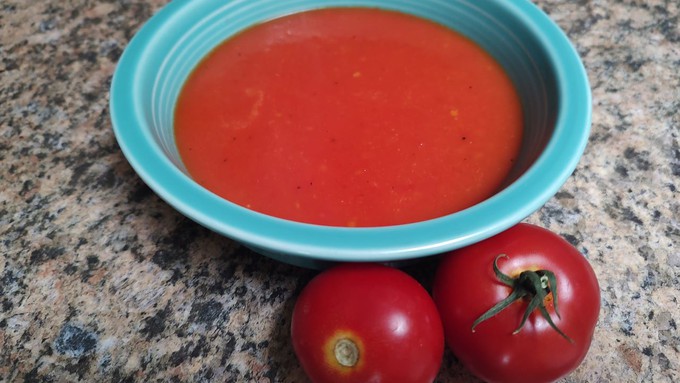
Recipe: Fresh tomato soup uses only five ingredients

This fresh tomato soup captures the peak flavor of ripe tomatoes and is easy to make. Debbie Arrington
What’s more Sacramentan than tomato soup? We didn’t get our Big Tomato nickname for nothing.
For generations, Campbell Soup made its famous tomato soup right here, using locally grown tomatoes.
And soup is an ideal use for late-season, really ripe, really juicy tomatoes; they’re packed with so much juice, this soup barely needs any extra liquid.
Fresh tomato soup requires very little seasoning; just a few dashes of garlic salt to complement the natural sweetness of the tomatoes. The food processor, blender or food mill makes it nice and smooth; no advance peeling necessary.
Fresh tomato soup
Makes 2 large bowls or 4 cups
Ingredients:
2 tablespoons butter or olive oil
½ cup onion, finely chopped
4 cups tomatoes, chopped
¼ to 1/2 teaspoon garlic salt
½ cup water
Instructions:
In a heavy saucepan, melt butter. Over medium heat, saute onion until soft.
Add chopped tomatoes including any juice. Sprinkle with garlic salt and stir. Cover pan and reduce heat. Simmer, stirring occasionally, until tomatoes are very, very soft, about 20 to 30 minutes.
In a food processor, blender or food mill, process tomato mixture until smooth. Return tomato mixture to pan and add water (a little more if needed).
Warm soup until it just starts to boil. Serve immediately.
Comments
0 comments have been posted.Sacramento Digs Gardening to your inbox.
Sites We Like
Garden Checklist for week of July 21
Your garden needs you!
* Keep your vegetable garden watered, mulched and weeded. Water before 8 a.m. to reduce the chance of fungal infection and to conserve moisture.
* Feed vegetable plants bone meal, rock phosphate or other fertilizers high in phosphate to stimulate more blooms and fruiting. (But wait until daily high temperatures drop out of the 100s.)
* Don’t let tomatoes wilt or dry out completely. Give tomatoes a deep watering two to three times a week.
* Harvest vegetables promptly to encourage plants to produce more. Squash especially tends to grow rapidly in hot weather. Keep an eye on zucchini.
* Pinch back chrysanthemums for bushy plants and more flowers in September.
* Remove spent flowers from roses, daylilies and other bloomers as they finish flowering.
* Pinch off blooms from basil so the plant will grow more leaves.
* Cut back lavender after flowering to promote a second bloom.
* It's not too late to add a splash of color. Plant petunias, snapdragons, zinnias and marigolds.
* From seed, plant corn, pumpkins, radishes, winter squash and sunflowers.